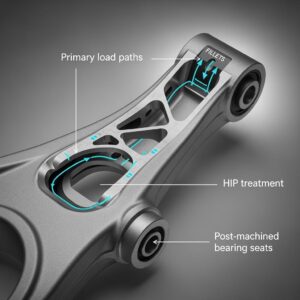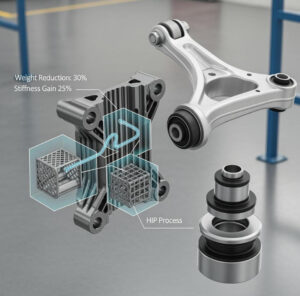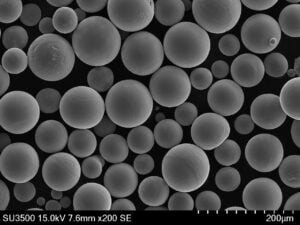High-Precision Rotor Mounts for Drones
目次
Introduction – The Critical Role of High-Precision Drone Rotor Mounts
In the rapidly evolving landscape of unmanned aerial vehicles (UAVs), commonly known as drones, every component plays a crucial role in ensuring optimal performance, safety, and longevity. Among these critical parts, the rotor mount stands out as a linchpin connecting the motor and the rotor blades. High-precision drone rotor mounts are not merely mechanical fasteners; they are integral to the stability, efficiency, and overall flight dynamics of the aircraft. In industries spanning from aerospace and defense to logistics and agriculture, the demand for drones with enhanced capabilities necessitates components engineered with exacting standards. Metal 3Dプリンティング, also known as metal additive manufacturing, has emerged as a transformative technology, offering unprecedented design freedom, material versatility, and the potential for creating high-precision parts like rotor mounts with tailored properties. This blog post delves into the significance of high-precision rotor mounts for drones and explores the compelling advantages of utilizing metal 3D printing for their production, with a focus on recommended materials such as AlSi10Mg and Scalmalloy®. At メタル3DP, we understand the critical nature of these components and are dedicated to providing cutting-edge additive manufacturing solutions.
What Makes High-Precision Rotor Mounts Essential for Drones?
The rotor mount serves as the crucial interface between the drone’s motor and its rotor blades. Its primary function is to securely hold the blades in place and transmit the rotational force generated by the motor. Any deviation in the mount’s design, material integrity, or manufacturing precision can have significant repercussions on the drone’s performance.
- Stability and Control: High-precision ensures minimal vibration and wobble during flight, contributing to overall stability and precise control. In applications like aerial photography, surveying, and inspection, even slight instability can lead to blurred images or inaccurate data.
- 効率が良い: A well-designed and precisely manufactured rotor mount ensures optimal power transfer from the motor to the blades, maximizing energy efficiency and extending flight times – a critical factor for commercial drone operations.
- 安全だ: The structural integrity of the rotor mount is paramount for flight safety. Failure of this component can lead to catastrophic consequences. High-precision manufacturing, especially with robust materials, minimizes the risk of fatigue, fracture, or detachment.
- Durability and Longevity: Drones in various industries are often subjected to demanding operational environments, including temperature variations, wind gusts, and mechanical stresses. High-precision rotor mounts made from durable materials can withstand these conditions, ensuring a longer lifespan for the drone.
- Reduced Noise: Precisely balanced rotor mounts contribute to quieter operation, which is increasingly important in urban environments and for applications like surveillance or wildlife monitoring.
Considering these factors, the demand for high-precision rotor mounts is steadily increasing across various sectors, including:
- 航空宇宙と防衛 For military surveillance drones, reconnaissance aircraft, and even future urban air mobility vehicles, reliability and precision are non-negotiable.
- 自動車: Drones are used for infrastructure inspection, logistics within manufacturing plants, and even potential future transportation solutions, all requiring dependable components.
- メディカルだ: Rapid delivery of medical supplies, organ transport, and emergency response often rely on drones with high operational reliability.
- 産業製造: Inspection of large industrial facilities, power lines, and pipelines benefits from stable and efficient drones equipped with precise components.
メタル3DP recognizes these critical demands and offers advanced metal 3D printing services to produce rotor mounts that meet the highest standards of precision and performance.

Why Metal 3D Printing is Revolutionizing Drone Rotor Mount Manufacturing
Traditional manufacturing methods like CNC machining have been used to produce drone components, including rotor mounts. However, metal 3D printing offers several compelling advantages that are revolutionizing the way these critical parts are designed and manufactured:
- デザインの自由と複雑さ: Additive manufacturing allows for the creation of intricate geometries that are difficult or impossible to achieve with traditional subtractive methods. This enables engineers to optimize the rotor mount design for weight reduction, improved aerodynamics, and enhanced functionality without the constraints of tooling.
- 素材の最適化: Metal 3D printing is compatible with a wide range of high-performance alloys, allowing for the selection of materials tailored to the specific demands of the drone application. As we will discuss further, materials like AlSi10Mg and Scalmalloy® offer excellent strength-to-weight ratios, crucial for drone performance. メタル3DP offers a diverse portfolio of high-quality metal powders to meet these needs.
- 軽量化: In the aerospace and drone industries, weight is a critical factor. Metal 3D printing facilitates the creation of lightweight yet structurally sound components through optimized designs and material selection, leading to longer flight times and increased payload capacity.
- Customization and Rapid Prototyping: Additive manufacturing enables the rapid production of prototypes with design iterations, significantly accelerating the development cycle. Furthermore, it allows for the customization of rotor mounts for specific drone models or applications without the need for expensive tooling changes, making it ideal for low-volume or specialized production.
- 廃棄物の削減: Compared to subtractive manufacturing processes that involve material removal, metal 3D printing adds material layer by layer, resulting in significantly less material waste and a more sustainable manufacturing approach.
- オンデマンド製造: Metal 3D printing allows for the production of rotor mounts on demand, reducing the need for large inventories and streamlining the supply chain. This is particularly beneficial for spare parts or customized components.
メタル3DP utilizes advanced metal 3D printing technologies to harness these advantages, providing high-precision rotor mounts that surpass the limitations of traditional manufacturing.
AlSi10Mg and Scalmalloy®: Advanced Materials for Superior Performance
The choice of material is paramount in determining the performance and reliability of drone rotor mounts. Metal 3D printing offers access to a range of advanced metal powders, and for high-precision drone applications, AlSi10Mg and Scalmalloy® stand out as exceptional choices:
AlSi10Mg:
- 構成: An aluminum-silicon-magnesium alloy known for its excellent strength-to-weight ratio, good thermal conductivity, and corrosion resistance.
- キー・プロパティ
- 高い強度: Offers significant mechanical strength, crucial for withstanding the stresses experienced during drone flight.
- 軽量だ: Its low density minimizes the overall weight of the drone, improving flight efficiency and payload capacity.
- Good Thermal Conductivity: Facilitates heat dissipation from the motor, enhancing performance and longevity.
- Excellent Processability: Well-suited for laser powder bed fusion (LPBF), a common metal 3D printing technique, resulting in dense and high-quality parts.
- 耐食性: Provides durability in various environmental conditions.
Scalmalloy®:
- 構成: A high-performance aluminum-magnesium-scandium alloy specifically developed for additive manufacturing, offering exceptional strength and lightweighting potential.
- キー・プロパティ
- 超高強度: Exhibits significantly higher strength compared to conventional aluminum alloys, enabling the production of even lighter and more robust rotor mounts.
- 優れた強度対重量比: Its combination of high strength and low density makes it ideal for demanding aerospace and drone applications where weight is critical.
- 延性が良い: Offers a good balance of strength and ductility, enhancing impact resistance.
- Weldability and Corrosion Resistance: Possesses good welding characteristics and resistance to corrosion.
The selection between AlSi10Mg and Scalmalloy® often depends on the specific performance requirements of the drone. For applications demanding ultimate lightweighting and high strength, Scalmalloy® offers a premium solution. AlSi10Mg provides an excellent balance of properties at a potentially more cost-effective price point.
メタル3DP offers both AlSi10Mg and Scalmalloy® powders, manufactured with our advanced powder making system, ensuring high sphericity and flowability for optimal 3D printing results. Our expertise in material science and additive manufacturing allows us to guide customers in selecting the most suitable material for their specific drone rotor mount applications.

Design Optimization for 3D Printed Drone Rotor Mounts
Designing for metal 3D printing requires a different mindset compared to traditional manufacturing. The layer-by-layer additive process opens up new possibilities for optimizing the geometry of drone rotor mounts for enhanced performance and reduced weight. Here are some key design considerations:
- Topology Optimization: This computational method can be used to identify and remove material from low-stress areas of the design, resulting in lightweight yet structurally sound parts. For rotor mounts, this can lead to complex internal lattice structures or organic shapes that minimize weight without compromising strength.
- Generative Design: Utilizing AI algorithms, generative design explores numerous design iterations based on specific performance requirements, material properties, and manufacturing constraints. This can lead to innovative and highly efficient rotor mount geometries that might not be intuitively conceived.
- 部品の統合: Metal 3D printing allows for the integration of multiple components into a single part. For example, a traditional rotor mount assembly with separate flanges, stiffeners, and connection points can potentially be redesigned and 3D printed as a single, monolithic structure. This reduces assembly time, minimizes potential failure points, and can improve overall structural integrity.
- Wall Thickness and Ribbing: Careful consideration of wall thickness and the incorporation of reinforcing ribs can optimize the stiffness-to-weight ratio. Strategic placement of ribs can provide significant structural support in critical areas without adding excessive mass.
- サポート体制: While 3D printing offers design freedom, overhanging features and complex geometries often require support structures during the printing process. Designing with self-supporting angles and minimizing overhangs can reduce the need for extensive support removal, saving time and material.
- Hollowing and Infill Patterns: For non-critical areas, hollowing out the interior of the rotor mount and utilizing optimized infill patterns can significantly reduce weight while maintaining sufficient structural integrity. Different infill densities and patterns can be chosen based on the specific load requirements.
- Surface Finish Considerations: The as-printed surface finish of metal 3D printed parts can vary depending on the material and printing process. Incorporating design features that minimize the need for extensive post-processing, such as strategically oriented surfaces, can reduce manufacturing costs.
By embracing these design principles, engineers can leverage the unique capabilities of metal 3D printing to create high-performance drone rotor mounts that are lighter, stronger, and more efficient than those manufactured using traditional methods. メタル3DP offers design consultation services to help customers optimize their parts for additive manufacturing.
Achieving Tight Tolerances and Smooth Surfaces in 3D Printed Rotor Mounts
Precision is paramount for drone rotor mounts to ensure proper motor alignment, blade balance, and overall flight stability. Metal 3D printing technologies have advanced significantly in their ability to achieve tight tolerances and smooth surface finishes.
- プロセス制御: Advanced metal 3D printers, like those offered by メタル3DP, incorporate sophisticated control systems that precisely manage the printing parameters, such as laser power, scan speed, and powder deposition. This precise control is crucial for achieving dimensional accuracy and consistent part quality.
- 高品質の金属粉末: The quality and characteristics of the metal powder significantly impact the final part’s accuracy and surface finish. Metal3DP’s advanced powder making system ensures the production of high-sphericity, uniform-sized powders like AlSi10Mg and Scalmalloy®, which contribute to smoother surfaces and tighter tolerances.
- ビルド方向: The orientation of the part during the printing process can influence both dimensional accuracy and surface roughness. Careful consideration of build orientation can minimize the step effect inherent in layer-by-layer manufacturing and reduce the need for extensive post-processing.
- Support Structure Optimization: While necessary for certain geometries, support structures can leave surface marks upon removal. Optimizing support design and placement can minimize these marks and improve the overall surface finish of critical areas.
- 後処理のテクニック: When very tight tolerances or smooth surface finishes are required, various post-processing techniques can be employed:
- CNC Machining: For critical interfaces or dimensions, precision CNC machining can be used to achieve very tight tolerances and smooth surface finishes on specific areas of the 3D printed rotor mount.
- 表面仕上げ: Techniques like abrasive blasting, polishing, and electrochemical polishing can be used to improve the surface roughness of the printed part.
- 熱処理: While primarily used to improve mechanical properties, controlled heat treatment can also contribute to dimensional stability.
By carefully controlling the 3D printing process and employing appropriate post-processing techniques, it is possible to achieve the tight tolerances and smooth surface finishes required for high-performance drone rotor mounts.

Streamlining Post-Processing for Durable and Reliable Rotor Mounts
While metal 3D printing offers numerous advantages, post-processing is often a necessary step to achieve the desired mechanical properties, surface finish, and dimensional accuracy for drone rotor mounts. Streamlining these processes is crucial for efficient production. Common post-processing requirements include:
- サポートの取り外し: As mentioned earlier, support structures are often needed during printing. Efficient and clean removal of these supports is essential. Design for manufacturability (DFM) principles can help minimize the need for extensive supports.
- 熱処理: To achieve the optimal mechanical properties of the chosen metal alloy (e.g., increased strength, hardness, or ductility), heat treatment processes are typically required. The specific heat treatment cycle depends on the material and the desired performance characteristics. For example, AlSi10Mg often undergoes stress relieving and age hardening.
- 表面仕上げ: Depending on the application and required surface roughness, various finishing techniques may be employed. These can range from simple abrasive blasting to more sophisticated methods like polishing or electrochemical polishing. For rotor mounts, smooth surfaces can improve aerodynamic performance and reduce stress concentrations.
- CNC Machining: For critical mating surfaces or features requiring very tight tolerances, precision CNC machining can be used as a secondary operation. This ensures accurate fit and functionality within the drone assembly.
- Inspection and Quality Control: Thorough inspection using techniques like coordinate measuring machines (CMM) or non-destructive testing (NDT) is crucial to ensure that the 3D printed rotor mounts meet the required dimensional accuracy and material integrity standards.
- Coating and Surface Treatments: In some applications, coatings may be applied to enhance corrosion resistance, wear resistance, or other specific properties. For example, anodizing can improve the corrosion resistance of aluminum alloys.
メタル3DP understands the importance of efficient post-processing and has established robust workflows and partnerships to provide comprehensive solutions, from printing to final finishing, ensuring the delivery of high-quality and reliable drone rotor mounts.
Overcoming Common Challenges in Metal 3D Printing of Rotor Mounts
While metal 3D printing offers significant advantages, certain challenges can arise during the manufacturing process. Understanding these potential issues and implementing appropriate strategies to mitigate them is crucial for successful production of drone rotor mounts:
- Warping and Distortion: Thermal stresses during the printing process can lead to warping or distortion of the part, especially for complex geometries or thin-walled structures.
- Mitigation: Optimizing part orientation, using support structures to anchor the part to the build plate, and carefully controlling the printing parameters can minimize warping. Simulation software can also help predict and prevent distortion.
- Residual Stresses: The rapid heating and cooling cycles in metal 3D printing can induce residual stresses within the part, potentially affecting its mechanical properties and dimensional stability.
- Mitigation: Stress-relieving heat treatments are commonly employed to reduce residual stresses and improve the overall performance of the printed parts.
- 多孔性: The presence of pores or voids within the printed material can compromise its strength and fatigue resistance.
- Mitigation: Optimizing printing parameters, using high-quality metal powders with good flowability (like those from メタル3DP), and ensuring proper shielding gas flow can minimize porosity. Hot isostatic pressing (HIP) can also be used as a post-processing step to densify the material.
- 表面粗さ: The layer-by-layer nature of 3D printing can result in a relatively rough surface finish compared to traditional machining.
- Mitigation: Optimizing build orientation, using smaller layer heights, and employing post-processing techniques like polishing or machining can improve surface finish.
- Support Removal Challenges: Removing support structures from intricate geometries can be time-consuming and may leave surface marks.
- Mitigation: Designing parts with self-supporting angles, optimizing support structure design for easy removal, and using dissolvable support materials (where applicable) can alleviate these issues.
- Material Property Consistency: Ensuring consistent material properties throughout the printed part and across different builds is crucial for reliability.
- Mitigation: Using well-controlled printing processes, high-quality materials from reputable suppliers like メタル3DP, and rigorous quality control procedures can ensure consistency.
By proactively addressing these potential challenges through careful design, optimized printing parameters, appropriate post-processing, and stringent quality control, it is possible to consistently produce high-quality and reliable metal 3D printed rotor mounts for demanding drone applications.

Selecting a Trusted Metal 3D Printing Service Provider for Drone Components
Choosing the right metal 3D printing service provider is a critical decision that can significantly impact the quality, cost, and lead time of your drone rotor mounts. Here are key factors to consider when evaluating potential suppliers:
- Material Capabilities: Ensure the provider has experience working with the specific metal alloys required for your application, such as AlSi10Mg and Scalmalloy®. They should be knowledgeable about the material properties and have optimized printing parameters for these materials. メタル3DP boasts extensive experience with a wide range of high-performance metal powders.
- Technology and Equipment: Inquire about the types of metal 3D printing technologies they utilize (e.g., Laser Powder Bed Fusion (LPBF), Direct Metal Laser Sintering (DMLS), Electron Beam Melting (EBM)). The choice of technology can influence the achievable precision, surface finish, and material properties. メタル3DP employs state-of-the-art Selective Electron Beam Melting (SEBM) printers known for their accuracy and reliability.
- Quality Assurance and Certifications: A reputable provider should have robust quality control processes in place, including material testing, dimensional inspection, and potentially industry-specific certifications (e.g., AS9100 for aerospace).
- Design and Engineering Support: Does the provider offer design consultation services to help optimize your rotor mount design for additive manufacturing? Their expertise can be invaluable in achieving lightweighting, part consolidation, and improved performance. メタル3DP provides comprehensive application development services, leveraging decades of collective expertise.
- Post-Processing Capabilities: Understand the provider’s in-house or partnered post-processing capabilities, including heat treatment, surface finishing, and CNC machining. A comprehensive service offering can streamline the entire manufacturing process.
- Experience and Expertise: Look for a provider with a proven track record in producing high-precision metal parts for demanding industries like aerospace, automotive, or medical. Their experience indicates their ability to handle complex projects and meet stringent requirements.
- Lead Times and Production Capacity: Discuss their typical lead times for similar parts and their production capacity to ensure they can meet your volume requirements and timelines.
- Communication and Customer Support: Effective communication and responsive customer support are essential for a smooth and successful collaboration.
- Cost Structure and Transparency: Understand their pricing model and ensure transparency in all cost components. Request a detailed quotation that outlines material costs, printing costs, post-processing fees, and any other applicable charges.
By carefully evaluating these factors, you can select a metal 3D printing service provider that aligns with your specific needs and ensures the delivery of high-quality, high-precision drone rotor mounts.
Understanding the Cost and Lead Time for 3D Printed Rotor Mounts
The cost and lead time for metal 3D printed drone rotor mounts are influenced by several factors. Understanding these can help in project planning and budgeting:
コスト要因:
- 材料費: The price of the metal powder (e.g., AlSi10Mg, Scalmalloy®) is a significant factor. Specialized alloys like Scalmalloy® typically have a higher material cost than more common alloys.
- Build Volume and Part Size: Larger parts that occupy more build volume on the 3D printer will generally incur higher costs due to increased material consumption and longer print times.
- 幾何学の複雑さ: Intricate designs with complex internal features or extensive support structures may require more printing time and post-processing, thus increasing costs.
- ビルドタイム: Longer print times directly translate to higher machine operation costs and energy consumption.
- 後処理の要件: The extent and type of post-processing required (e.g., heat treatment, surface finishing, CNC machining) will add to the overall cost.
- 人件費: The expertise required for design optimization, print setup, post-processing, and quality control contributes to the overall cost.
- Quantity and Production Volume: While 3D printing is often advantageous for low to medium volumes and customization, higher production volumes may benefit from economies of scale. However, unlike traditional manufacturing, there are typically no tooling costs associated with metal 3D printing, which can be a significant advantage for smaller batches.
Lead Time Factors:
- Part Complexity and Size: More complex and larger parts generally require longer print times.
- 材料の入手可能性: The availability of the specific metal powder can impact lead times. メタル3DP maintains a stock of its high-quality metal powders to minimize delays.
- Printer Availability and Capacity: The workload and availability of the 3D printers at the service provider’s facility will influence lead times.
- Post-Processing Duration: The time required for post-processing steps like heat treatment, surface finishing, and inspection will add to the overall lead time.
- Shipping and Logistics: The time taken for shipping the finished parts to your location also needs to be considered.
It’s essential to discuss these factors with your chosen metal 3D printing service provider to get an accurate estimate of both the cost and lead time for your specific drone rotor mount requirements.

よくある質問(FAQ)
- What are the typical tolerances achievable with metal 3D printing for drone rotor mounts? Metal 3D printing can achieve tolerances ranging from ±0.1 mm to ±0.05 mm, depending on the material, printing process, and part geometry. Finer tolerances can be achieved through post-processing like CNC machining. Metal3DP’s SEBM technology is known for its high accuracy, and we can discuss specific tolerance requirements based on your design.
- Can metal 3D printed rotor mounts be as strong as those made with traditional methods? Yes, metal 3D printed parts, especially when using high-performance alloys like AlSi10Mg and Scalmalloy® and subjected to appropriate post-processing (e.g., heat treatment, HIP), can achieve mechanical properties comparable to or even exceeding those of traditionally manufactured parts. The layer-by-layer build process can even result in improved material homogeneity in certain cases.
- Is metal 3D printing cost-effective for producing drone rotor mounts? The cost-effectiveness of metal 3D printing depends on factors like part complexity, production volume, material choice, and the cost of traditional alternatives. For complex geometries, low to medium volumes, and customized parts, metal 3D printing can be very cost-competitive due to the absence of tooling costs and the potential for lightweighting and part consolidation.
Conclusion – The Future of Drone Rotor Mounts with Metal 3D Printing
Metal 3D printing is revolutionizing the design and manufacturing of high-precision drone rotor mounts. Its ability to handle advanced materials like AlSi10Mg and Scalmalloy®, enable complex geometries, facilitate lightweighting, and offer customization makes it an ideal technology for the demanding requirements of the drone industry. Companies like メタル3DP are at the forefront of this innovation, providing cutting-edge metal AM equipment, high-quality metal powders, and comprehensive application development services to empower organizations in aerospace, automotive, medical, and industrial manufacturing. As drone technology continues to advance, the role of metal 3D printing in producing critical components like rotor mounts will only become more significant, driving performance, efficiency, and reliability to new heights. Contact メタル3DP today to explore how our capabilities can power your organization’s additive manufacturing goals for drone technology.
シェアする
MET3DP Technology Co., LTDは、中国青島に本社を置く積層造形ソリューションのリーディングプロバイダーです。弊社は3Dプリンティング装置と工業用途の高性能金属粉末を専門としています。
関連記事










